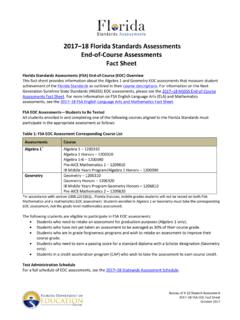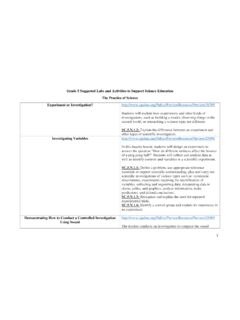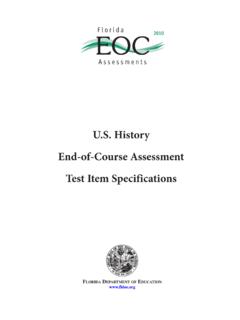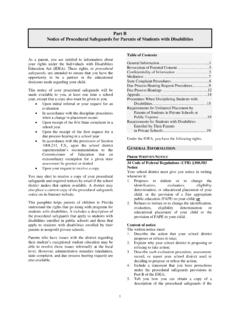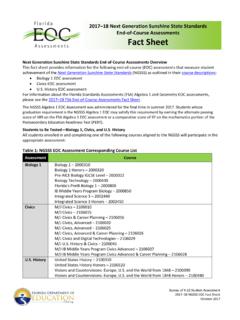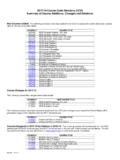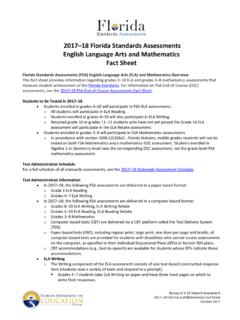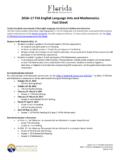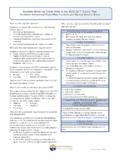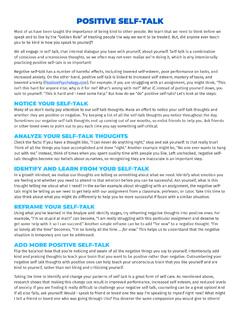Transcription of Florida K-12 Mathematical Thinking and Reasoning …
1 1 | P a g e Florida K-12 Mathematical Thinking and Reasoning Standards MTR: Because Math Matters Florida students are expected to engage with mathematics through the Mathematical Thinking and Reasoning (MTR) Standards. These standards are written in clear language so all stakeholders can understand them and students can use them as self-monitoring tools. The MTR Standards promote deeper learning and understanding of mathematics. The clarifications are included to guide teachers in the integration of the MTR Standards within mathematics instruction. Actively participate in effortful learning both individually and collectively. Mathematicians who participate in effortful learning both individually and with others: Analyze the problem in a way that makes sense given the task. Ask questions that will help with solving the task.
2 Build perseverance by modifying methods as needed while solving a challenging task. Stay engaged and maintain a positive mindset when working to solve tasks. Help and support each other when attempting a new method or approach. Clarifications: Teachers who encourage students to participate actively in effortful learning both individually and with others: Cultivate a community of growth mindset learners. Foster perseverance in students by choosing tasks that are challenging. Develop students ability to analyze and problem solve. Recognize students effort when solving challenging problems. 2 | P a g e Demonstrate understanding by representing problems in multiple ways. Mathematicians who demonstrate understanding by representing problems in multiple ways: Build understanding through modeling and using manipulatives.
3 Represent solutions to problems in multiple ways using objects, drawings, tables, graphs and equations. Progress from modeling problems with objects and drawings to using algorithms and equations. Express connections between concepts and representations. Choose a representation based on the given context or purpose. Clarifications: Teachers who encourage students to demonstrate understanding by representing problems in multiple ways: Help students make connections between concepts and representations. Provide opportunities for students to use manipulatives when investigating concepts. Guide students from concrete to pictorial to abstract representations as understanding progresses. Show students that various representations can have different purposes and can be useful in different situations.
4 Complete tasks with Mathematical fluency. Mathematicians who complete tasks with Mathematical fluency: Select efficient and appropriate methods for solving problems within the given context. Maintain flexibility and accuracy while performing procedures and mental calculations. Complete tasks accurately and with confidence. Adapt procedures to apply them to a new context. Use feedback to improve efficiency when performing calculations. Clarifications: Teachers who encourage students to complete tasks with Mathematical fluency: Provide students with the flexibility to solve problems by selecting a procedure that allows them to solve efficiently and accurately. Offer multiple opportunities for students to practice efficient and generalizable methods. Provide opportunities for students to reflect on the method they used and determine if a more efficient method could have been used.
5 3 | P a g e Engage in discussions that reflect on the Mathematical Thinking of self and others. Mathematicians who engage in discussions that reflect on the Mathematical Thinking of self and others: Communicate Mathematical ideas, vocabulary and methods effectively. Analyze the Mathematical Thinking of others. Compare the efficiency of a method to those expressed by others. Recognize errors and suggest how to correctly solve the task. Justify results by explaining methods and processes. Construct possible arguments based on evidence. Clarifications: Teachers who encourage students to engage in discussions that reflect on the Mathematical Thinking of self and others: Establish a culture in which students ask questions of the teacher and their peers, and error is an opportunity for learning.
6 Create opportunities for students to discuss their Thinking with peers. Select, sequence and present student work to advance and deepen understanding of correct and increasingly efficient methods. Develop students ability to justify methods and compare their responses to the responses of their peers. Use patterns and structure to help understand and connect Mathematical concepts. Mathematicians who use patterns and structure to help understand and connect Mathematical concepts: Focus on relevant details within a problem. Create plans and procedures to logically order events, steps or ideas to solve problems. Decompose a complex problem into manageable parts. Relate previously learned concepts to new concepts. Look for similarities among problems. Connect solutions of problems to more complicated large-scale situations.
7 Clarifications: Teachers who encourage students to use patterns and structure to help understand and connect Mathematical concepts: Help students recognize the patterns in the world around them and connect these patterns to Mathematical concepts. Support students to develop generalizations based on the similarities found among problems. Provide opportunities for students to create plans and procedures to solve problems. Develop students ability to construct relationships between their current understanding and more sophisticated ways of Thinking . 4 | P a g e Assess the reasonableness of solutions. Mathematicians who assess the reasonableness of solutions: Estimate to discover possible solutions. Use benchmark quantities to determine if a solution makes sense. Check calculations when solving problems.
8 Verify possible solutions by explaining the methods used. Evaluate results based on the given context. Clarifications: Teachers who encourage students to assess the reasonableness of solutions: Have students estimate or predict solutions prior to solving. Prompt students to continually ask, Does this solution make sense? How do you know? Reinforce that students check their work as they progress within and after a task. Strengthen students ability to verify solutions through justifications. Apply mathematics to real-world contexts. Mathematicians who apply mathematics to real-world contexts: Connect Mathematical concepts to everyday experiences. Use models and methods to understand, represent and solve problems. Perform investigations to gather data or determine if a method is appropriate.
9 Redesign models and methods to improve accuracy or efficiency. Clarifications: Teachers who encourage students to apply mathematics to real-world contexts: Provide opportunities for students to create models, both concrete and abstract, and perform investigations. Challenge students to question the accuracy of their models and methods. Support students as they validate conclusions by comparing them to the given situation. Indicate how various concepts can be applied to other disciplines.
